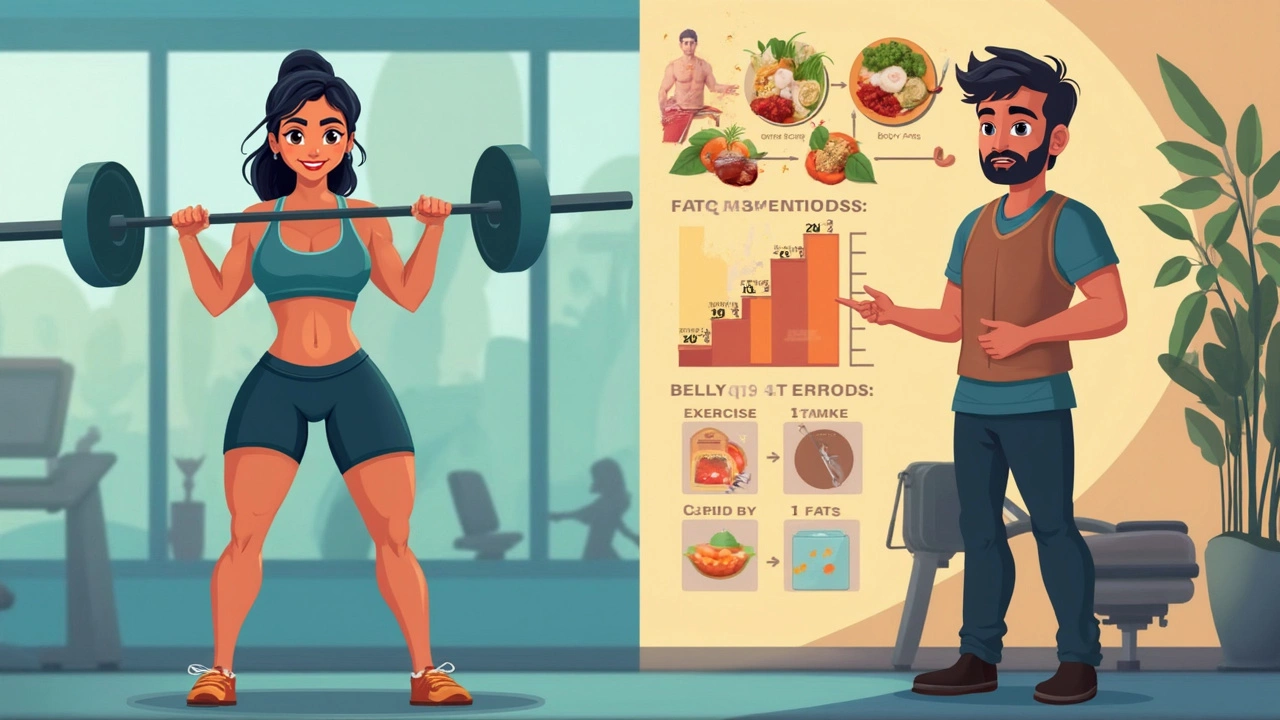Ever find yourself at the gym grinding out squat after squat, silently hoping your belly will shrink with every rep? You’re not alone. Squats have a reputation for being this magical move that somehow burns off stomach fat, but the reality is a bit more complicated.
If you’re chasing a flatter stomach, it’s easy to get stuck on the idea that you can target belly fat by just picking the “right” exercise. But even the best personal trainers will tell you: fat loss doesn’t work like that.
Let’s make this clear—squats are amazing for your legs and your butt. They even work your core. But expecting them to burn away just your belly fat? That’s not how our bodies operate.
Want to actually slim down your waistline? There’s more to it than just hammering out extra sets of squats. Stick around for some eye-opening facts and no-nonsense tips that you can actually use the next time you hit the gym.
- The Squat Hype: Why Squats Get All the Attention
- How Fat Loss Actually Works
- Are Spot Reduction Claims Real?
- What Squats Actually Do For Your Body
- Better Strategies For Burning Belly Fat
- How to Build a Smarter Workout Plan
The Squat Hype: Why Squats Get All the Attention
If you ask anyone at the gym about the best exercise, squats usually get all the praise. They’re famous for building strong legs and a shaped backside, but somehow, they got wrapped up in promises of burning belly fat too. Where did that hype even come from?
Simpler moves like bicep curls only work one muscle group, but squats use almost everything—quads, glutes, hamstrings, lower back, and even your core. Fitness experts label this as a “compound movement,” which sounds fancy but just means a move that challenges several muscles at once. So squats are a big deal in any gym workout plan for hitting multiple zones at once.
The real buzz started when trainers noticed how tough squats are and how they get your heart rate up. That’s where the idea kicked off that if you’re breathless, you’re torching more calories and therefore burning fat—even from your stomach. But does it really work that way?
"Squats are great for building muscle and boosting calorie burn, but they can’t choose where your body loses fat from. That’s just not how fat loss works." — Dr. Kara Mohr, Exercise Physiologist, IDEA Fitness Journal
To put it in perspective, check this quick glance at what body parts squats actually target the most.
| Muscle Group | Primary or Secondary |
|---|---|
| Quads | Primary |
| Glutes | Primary |
| Hamstrings | Secondary |
| Core | Secondary |
| Lower Back | Secondary |
In the end, squats get the spotlight because they offer a ton of benefits in one move and leave you feeling like you’ve really worked out. But when it comes to reducing specifically belly fat, they aren’t the magic bullet some people hope for. Don’t worry though—squats still deserve a solid spot in your routine, just maybe not for the reasons everyone keeps shouting about.
How Fat Loss Actually Works
Here’s the real scoop—fat loss isn’t about tricking your body or picking a single magic move like squats. Your body stores fat as an energy reserve, and you only lose it when you burn more calories than you take in. It doesn’t come off wherever you want, no matter how many crunches or squat sets you squeeze in. Your body decides where to pull energy from, and it usually goes on its own schedule.
This whole process is about creating what’s called a calorie deficit. That just means you’re using up more energy than you’re eating. It’s like your wallet—if you spend more money than you make, your savings start to shrink. And just like that, your belly fat gets tapped for energy and gradually goes down.
- You burn calories all day—from basic body functions like breathing plus whatever you do at the gym or even just walking around.
- Diet plays a big part. You can’t out-squat a steady stream of high-calorie snacks, sadly.
- When you lose fat, your body pulls it from all over, not just your belly.
Want a number to help you out? To lose about 1 pound of fat a week, you’d need a calorie deficit of roughly 500 calories per day. That isn’t an exact science for everyone, but it’s a good place to start. Check out this table for a quick example:
| Calories In | Calories Out | Result |
|---|---|---|
| 2200 | 2200 | No fat loss |
| 2000 | 2500 | Lose ~1 pound/week |
| 2500 | 2000 | Gain fat |
So, if you’re after less belly fat, focus on making small adjustments to both your food intake and your movement. Gym workouts are great, but your overall activity—and what you eat every day—matters much more for actual fat loss.
Are Spot Reduction Claims Real?
If you search “how to lose belly fat,” you’ll find all kinds of tips saying you just need to do more squats or crunches for a flat stomach. Here’s the truth: spot reduction—the idea you can burn fat from only one part of your body by exercising that spot—just doesn’t add up.
Science backs this up. For example, a study from 2011 in the Journal of Strength and Conditioning Research had people do hundreds of ab exercises over several weeks. Did they lose belly fat? Nope. They lost about the same amount everywhere, not just the belly. The body chooses where to burn fat based on your genetics and hormones, not your exercise routine.
When you do gym workouts like squats, your muscles in that area get stronger and sometimes a bit bigger. But burning off fat in that exact spot—like your stomach or thighs—just doesn’t happen from one exercise.
- If you lose body fat, it’s pulled from all over—not just one spot.
- Everyone’s body takes fat from different places faster or slower, thanks to your genes.
- No single move, not even the mighty squat, can force belly fat to disappear first.
So, when you see ads promising that a certain ab move or number of squats burns off belly fat, take it with a big grain of salt. Focus on moves that train lots of muscles and raise your heart rate, because those will make a bigger impact on your overall fat loss results.
| Action | Belly Fat Loss? |
|---|---|
| Squats only | Nope |
| Ab exercises only | Nope |
| Full-body workouts + healthy eating | Yes (but everywhere, not just belly) |

What Squats Actually Do For Your Body
Squats aren't just a cool move for showing off in the gym. When you do them right, they target almost every muscle in your lower body. Your glutes, hamstrings, and quads are the main muscles in action, but your abs and lower back join the party to keep you stable.
Here's what really happens with squats and your body:
- Builds muscle and strength: Regular squatting increases muscle size in your legs and butt. Over time, this helps you move better and lift heavier stuff in your daily life.
- Boosts calorie burn: Big moves like squats use more energy than small, single-joint exercises. This means more calories burned, which does play a role in overall fat loss, not just belly fat.
- Toughens up your core: Squats aren’t just a leg move—they make your abdominal and lower back muscles work hard to keep your balance. That’s why you often feel your core after a tough squat session.
- Improves mobility: Going deep in a squat stretches your hips, ankles, and knees. This can help you move better, not just at the gym but everywhere—from playing sports to picking up groceries.
Think about this: one study from 2023 published in the Journal of Strength and Conditioning Research found that people who did squats twice a week boosted their leg strength by up to 25% in just eight weeks.
But, and this is key, none of the changes happen in just one spot. Your body can't single out belly fat to burn—it will pull fat from everywhere, based on genes and overall activity. So, while squats will tighten and grow your muscles, your actual fat loss comes down to burning more calories than you take in.
Here’s a quick breakdown of what squats target and how they help you:
| Muscle Group | Main Benefit |
|---|---|
| Glutes & Quads | Strength, muscle growth |
| Hamstrings | Stability, power |
| Core (abs & back) | Balance, posture |
| Calves | Support joint movement |
So yeah, squats are amazing for shaping your body and helping you burn calories, which is part of the bigger fat loss journey. But don’t fall for the myth that squats alone will give you a flat stomach.
Better Strategies For Burning Belly Fat
If you’re serious about losing belly fat, it takes more than just squats. The number one thing that actually works is burning more calories than you eat—a calorie deficit. That’s not as exciting as a new exercise trend, but it’s what works every time.
Cardio gets your heart rate up and uses plenty of energy, which helps you burn fat all over—even around your midsection. Mixing different types like brisk walking, cycling, or HIIT (high-intensity interval training) keeps things interesting and effective. Researchers found that HIIT, which swaps between bursts of activity and rest, can burn as much as 20-30% more calories than regular cardio in the same amount of time.
| Activity | Calories Burned per 30 min* |
|---|---|
| Jogging | 250 |
| HIIT | 300 |
| Brisk Walking | 140 |
| Cycling | 210 |
*Calories burned is estimated for a 70kg person. Real numbers depend on your body weight and intensity.
You also can’t ignore food. Even a killer gym workout can’t outdo a diet full of extra calories. Swapping sugar-loaded snacks for lean proteins, veggies, and whole grains makes a real difference. Tracking your meals—even just for a week—can help spot sneaky habits holding you back.
- Lift weights to build muscle (muscle burns calories even at rest!)
- Include regular cardio sessions—mix it up so you don’t get bored
- Eat more protein at every meal to stay full and rebuild muscles
- Watch out for hidden calories in drinks and snacks
- Get enough sleep, because too little sleep messes with your hunger hormones
One more thing—consistency is everything. There’s no quick fix. Mix up your squats, include different movements, keep your food in check, and trust the process. That’s how real change happens.
How to Build a Smarter Workout Plan
Building a smart plan goes way beyond just stacking up sets of squats or hoping a single move will burn all your belly fat. What works is a solid mix of different training types and, honestly, some patience.
If you want real fat loss (including at the belly), combine strength training, cardio, and healthy eating. Here’s how smart gym-goers are doing it:
- Balance is key: Don’t skip strength training just because you want to lose fat. Lifting weights helps you keep muscle, which burns more calories even at rest.
- Cardio still matters: Throw in both moderate and high-intensity cardio. Think treadmill sprints, jump rope, cycling, or even dance classes—these help torch calories fast.
- Squats have their place: Do squats to build muscle and boost your metabolism, but don’t expect them to be a fat-burning magic trick for your stomach.
- Switch things up: Mix your workouts often. Your body can get used to the same routine and stop responding. Try circuit workouts, interval training, or different class styles.
- Food = results: No workout plan skips nutrition. Track your eating, balance your protein, carbs, and fats, and avoid drinking all your calories.
Here’s a quick look at how much your body actually burns—both at rest and during different activities:
| Activity | Calories Burned/Hour (average, 150lb person) |
|---|---|
| Squats (weight lifting) | 200-400 |
| Running (6 mph) | 660 |
| Walking (3 mph) | 240 |
| Resting Metabolic Rate | 60-80/hour |
The bottom line? A smart gym workout plan is never just about one exercise. Mix strength training (like squats) with real cardio and a solid eating plan. Review your progress every few weeks and tweak things so you keep moving toward your goals. It’s not fancy—but it works.





